Auditing Letter 2022
VerifiedAdded on 2022/10/11
|7
|1326
|43
AI Summary
Contribute Materials
Your contribution can guide someone’s learning journey. Share your
documents today.
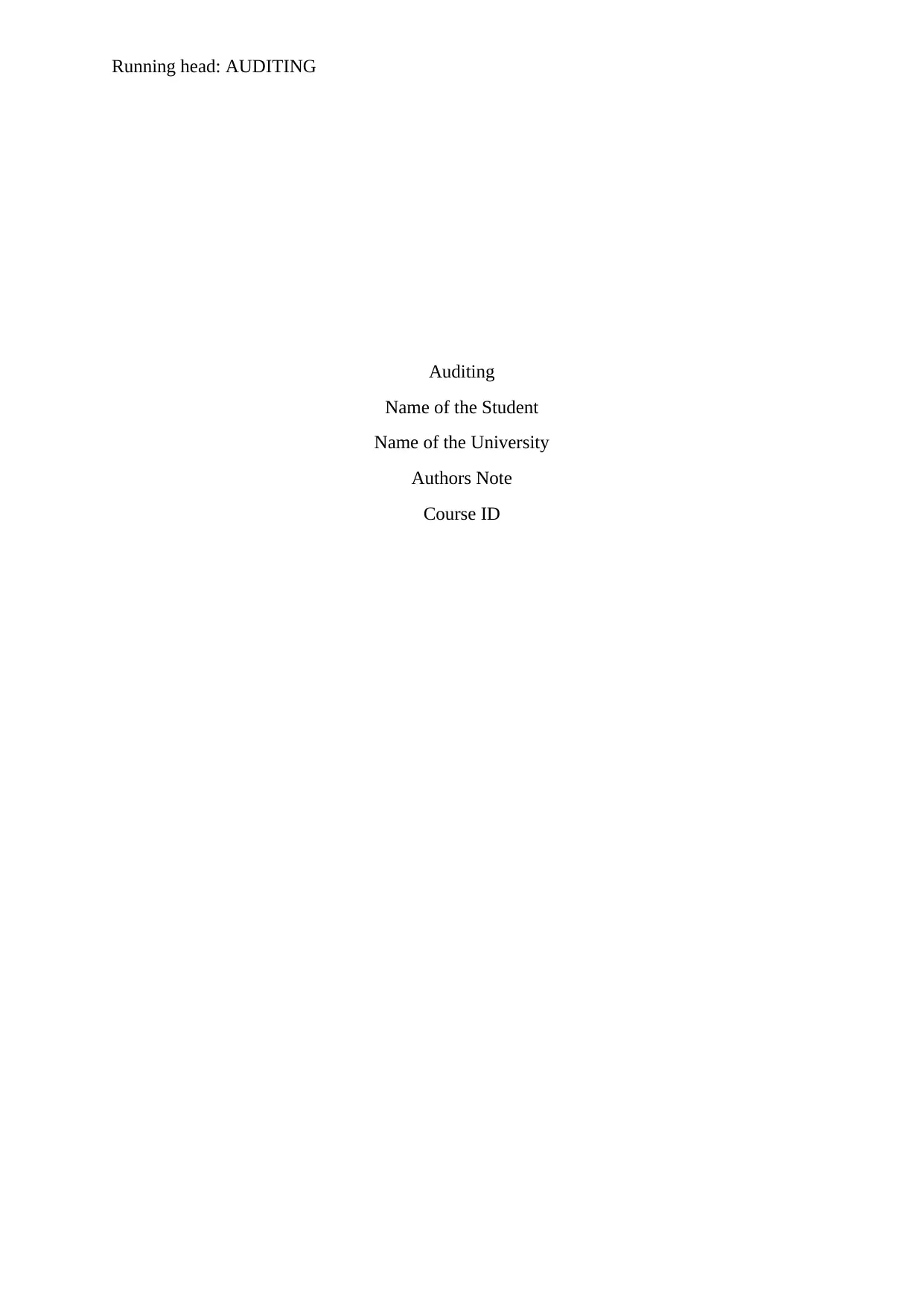
Running head: AUDITING
Auditing
Name of the Student
Name of the University
Authors Note
Course ID
Auditing
Name of the Student
Name of the University
Authors Note
Course ID
Secure Best Marks with AI Grader
Need help grading? Try our AI Grader for instant feedback on your assignments.
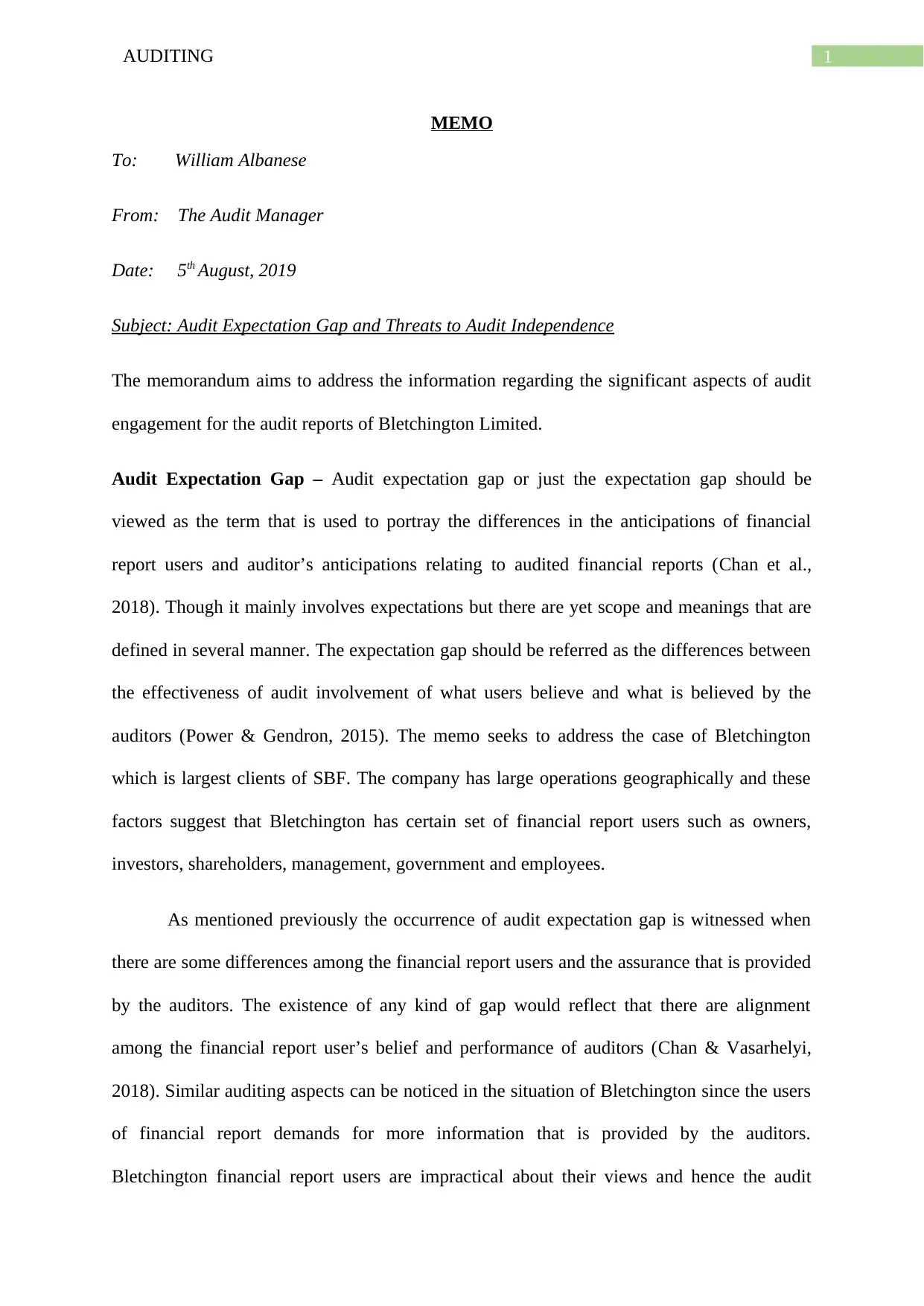
1AUDITING
MEMO
To: William Albanese
From: The Audit Manager
Date: 5th August, 2019
Subject: Audit Expectation Gap and Threats to Audit Independence
The memorandum aims to address the information regarding the significant aspects of audit
engagement for the audit reports of Bletchington Limited.
Audit Expectation Gap – Audit expectation gap or just the expectation gap should be
viewed as the term that is used to portray the differences in the anticipations of financial
report users and auditor’s anticipations relating to audited financial reports (Chan et al.,
2018). Though it mainly involves expectations but there are yet scope and meanings that are
defined in several manner. The expectation gap should be referred as the differences between
the effectiveness of audit involvement of what users believe and what is believed by the
auditors (Power & Gendron, 2015). The memo seeks to address the case of Bletchington
which is largest clients of SBF. The company has large operations geographically and these
factors suggest that Bletchington has certain set of financial report users such as owners,
investors, shareholders, management, government and employees.
As mentioned previously the occurrence of audit expectation gap is witnessed when
there are some differences among the financial report users and the assurance that is provided
by the auditors. The existence of any kind of gap would reflect that there are alignment
among the financial report user’s belief and performance of auditors (Chan & Vasarhelyi,
2018). Similar auditing aspects can be noticed in the situation of Bletchington since the users
of financial report demands for more information that is provided by the auditors.
Bletchington financial report users are impractical about their views and hence the audit
MEMO
To: William Albanese
From: The Audit Manager
Date: 5th August, 2019
Subject: Audit Expectation Gap and Threats to Audit Independence
The memorandum aims to address the information regarding the significant aspects of audit
engagement for the audit reports of Bletchington Limited.
Audit Expectation Gap – Audit expectation gap or just the expectation gap should be
viewed as the term that is used to portray the differences in the anticipations of financial
report users and auditor’s anticipations relating to audited financial reports (Chan et al.,
2018). Though it mainly involves expectations but there are yet scope and meanings that are
defined in several manner. The expectation gap should be referred as the differences between
the effectiveness of audit involvement of what users believe and what is believed by the
auditors (Power & Gendron, 2015). The memo seeks to address the case of Bletchington
which is largest clients of SBF. The company has large operations geographically and these
factors suggest that Bletchington has certain set of financial report users such as owners,
investors, shareholders, management, government and employees.
As mentioned previously the occurrence of audit expectation gap is witnessed when
there are some differences among the financial report users and the assurance that is provided
by the auditors. The existence of any kind of gap would reflect that there are alignment
among the financial report user’s belief and performance of auditors (Chan & Vasarhelyi,
2018). Similar auditing aspects can be noticed in the situation of Bletchington since the users
of financial report demands for more information that is provided by the auditors.
Bletchington financial report users are impractical about their views and hence the audit

2AUDITING
engagement partner might be facing some unrealistic expectations. Below outlined are some
of the unrealistic expectations of users;
a. The auditors of Bletchington should provide the future guarantee regarding the
feasibility of information.
b. Bletchington auditors should provide complete assurance
c. The auditors would provide the unqualified audit opinion which means that all the
accounts of the company are accurate
d. The auditors would certainly locate any existence of frauds and error if they are
present in the financial report of Bletchington.
e. Each transactions of Bletchington should be checked in detail by the auditors.
As understood, the auditors have been failure in meeting the above given audit
expectation which has resulted in the audit expectation gap. The auditors are responsible for
the outlined aspects below;
a. The auditors are accountable for giving reasonable assurance
b. The auditors does not provide the guarantee for the company’s future viability
c. The auditors are accountable for giving unqualified audit opinion when they
understand that there is no such material misstatement in the company’s financial
reports
d. The auditors cannot provide any guarantee of fact that there are no such existence of
fraud however it is their accountability of taking appropriate steps in case of frauds
(Roussy & Brivot, 2016).
e. The auditors are accountable for testing the sample of financial reports of entities.
engagement partner might be facing some unrealistic expectations. Below outlined are some
of the unrealistic expectations of users;
a. The auditors of Bletchington should provide the future guarantee regarding the
feasibility of information.
b. Bletchington auditors should provide complete assurance
c. The auditors would provide the unqualified audit opinion which means that all the
accounts of the company are accurate
d. The auditors would certainly locate any existence of frauds and error if they are
present in the financial report of Bletchington.
e. Each transactions of Bletchington should be checked in detail by the auditors.
As understood, the auditors have been failure in meeting the above given audit
expectation which has resulted in the audit expectation gap. The auditors are responsible for
the outlined aspects below;
a. The auditors are accountable for giving reasonable assurance
b. The auditors does not provide the guarantee for the company’s future viability
c. The auditors are accountable for giving unqualified audit opinion when they
understand that there is no such material misstatement in the company’s financial
reports
d. The auditors cannot provide any guarantee of fact that there are no such existence of
fraud however it is their accountability of taking appropriate steps in case of frauds
(Roussy & Brivot, 2016).
e. The auditors are accountable for testing the sample of financial reports of entities.
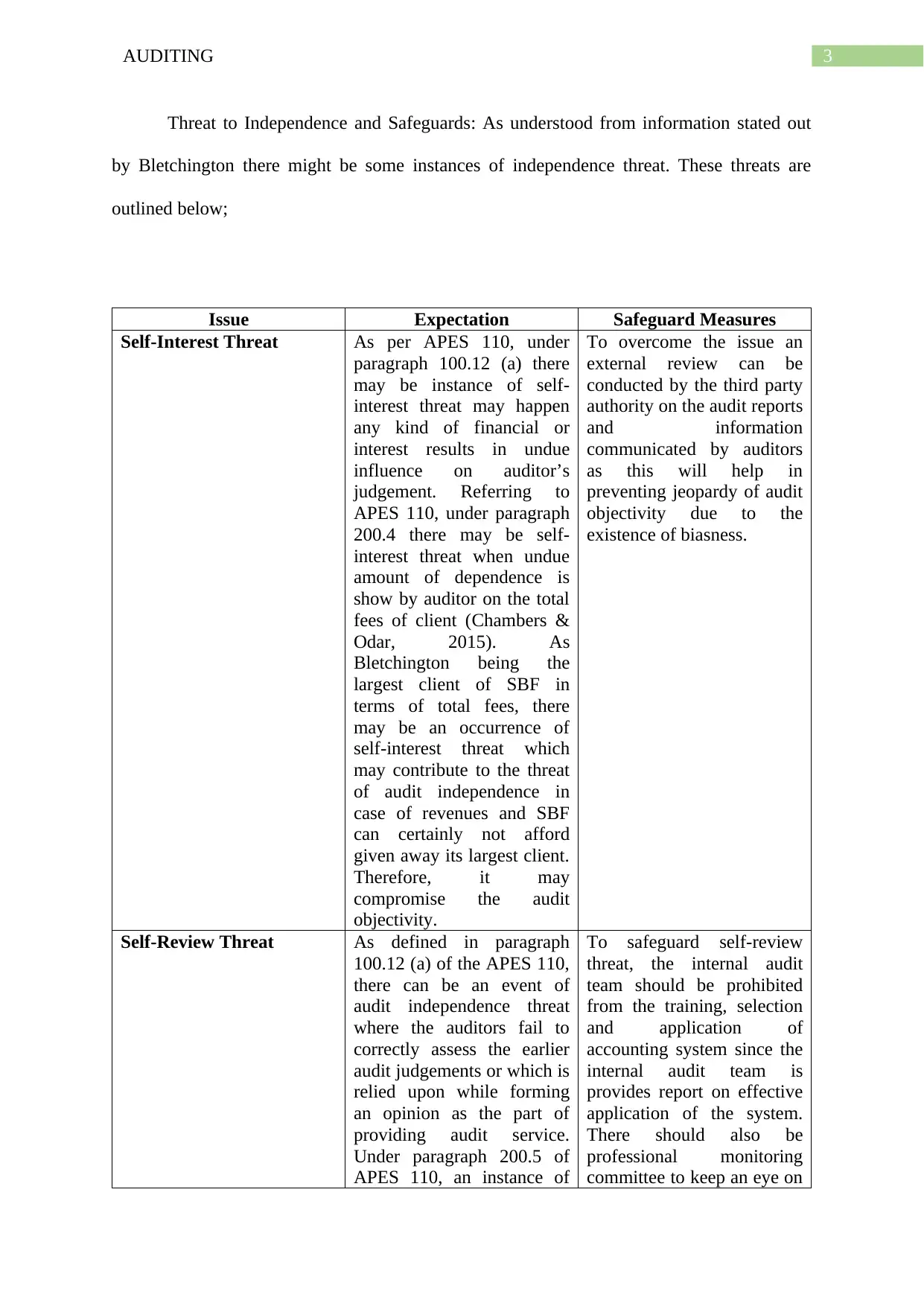
3AUDITING
Threat to Independence and Safeguards: As understood from information stated out
by Bletchington there might be some instances of independence threat. These threats are
outlined below;
Issue Expectation Safeguard Measures
Self-Interest Threat As per APES 110, under
paragraph 100.12 (a) there
may be instance of self-
interest threat may happen
any kind of financial or
interest results in undue
influence on auditor’s
judgement. Referring to
APES 110, under paragraph
200.4 there may be self-
interest threat when undue
amount of dependence is
show by auditor on the total
fees of client (Chambers &
Odar, 2015). As
Bletchington being the
largest client of SBF in
terms of total fees, there
may be an occurrence of
self-interest threat which
may contribute to the threat
of audit independence in
case of revenues and SBF
can certainly not afford
given away its largest client.
Therefore, it may
compromise the audit
objectivity.
To overcome the issue an
external review can be
conducted by the third party
authority on the audit reports
and information
communicated by auditors
as this will help in
preventing jeopardy of audit
objectivity due to the
existence of biasness.
Self-Review Threat As defined in paragraph
100.12 (a) of the APES 110,
there can be an event of
audit independence threat
where the auditors fail to
correctly assess the earlier
audit judgements or which is
relied upon while forming
an opinion as the part of
providing audit service.
Under paragraph 200.5 of
APES 110, an instance of
To safeguard self-review
threat, the internal audit
team should be prohibited
from the training, selection
and application of
accounting system since the
internal audit team is
provides report on effective
application of the system.
There should also be
professional monitoring
committee to keep an eye on
Threat to Independence and Safeguards: As understood from information stated out
by Bletchington there might be some instances of independence threat. These threats are
outlined below;
Issue Expectation Safeguard Measures
Self-Interest Threat As per APES 110, under
paragraph 100.12 (a) there
may be instance of self-
interest threat may happen
any kind of financial or
interest results in undue
influence on auditor’s
judgement. Referring to
APES 110, under paragraph
200.4 there may be self-
interest threat when undue
amount of dependence is
show by auditor on the total
fees of client (Chambers &
Odar, 2015). As
Bletchington being the
largest client of SBF in
terms of total fees, there
may be an occurrence of
self-interest threat which
may contribute to the threat
of audit independence in
case of revenues and SBF
can certainly not afford
given away its largest client.
Therefore, it may
compromise the audit
objectivity.
To overcome the issue an
external review can be
conducted by the third party
authority on the audit reports
and information
communicated by auditors
as this will help in
preventing jeopardy of audit
objectivity due to the
existence of biasness.
Self-Review Threat As defined in paragraph
100.12 (a) of the APES 110,
there can be an event of
audit independence threat
where the auditors fail to
correctly assess the earlier
audit judgements or which is
relied upon while forming
an opinion as the part of
providing audit service.
Under paragraph 200.5 of
APES 110, an instance of
To safeguard self-review
threat, the internal audit
team should be prohibited
from the training, selection
and application of
accounting system since the
internal audit team is
provides report on effective
application of the system.
There should also be
professional monitoring
committee to keep an eye on
Secure Best Marks with AI Grader
Need help grading? Try our AI Grader for instant feedback on your assignments.
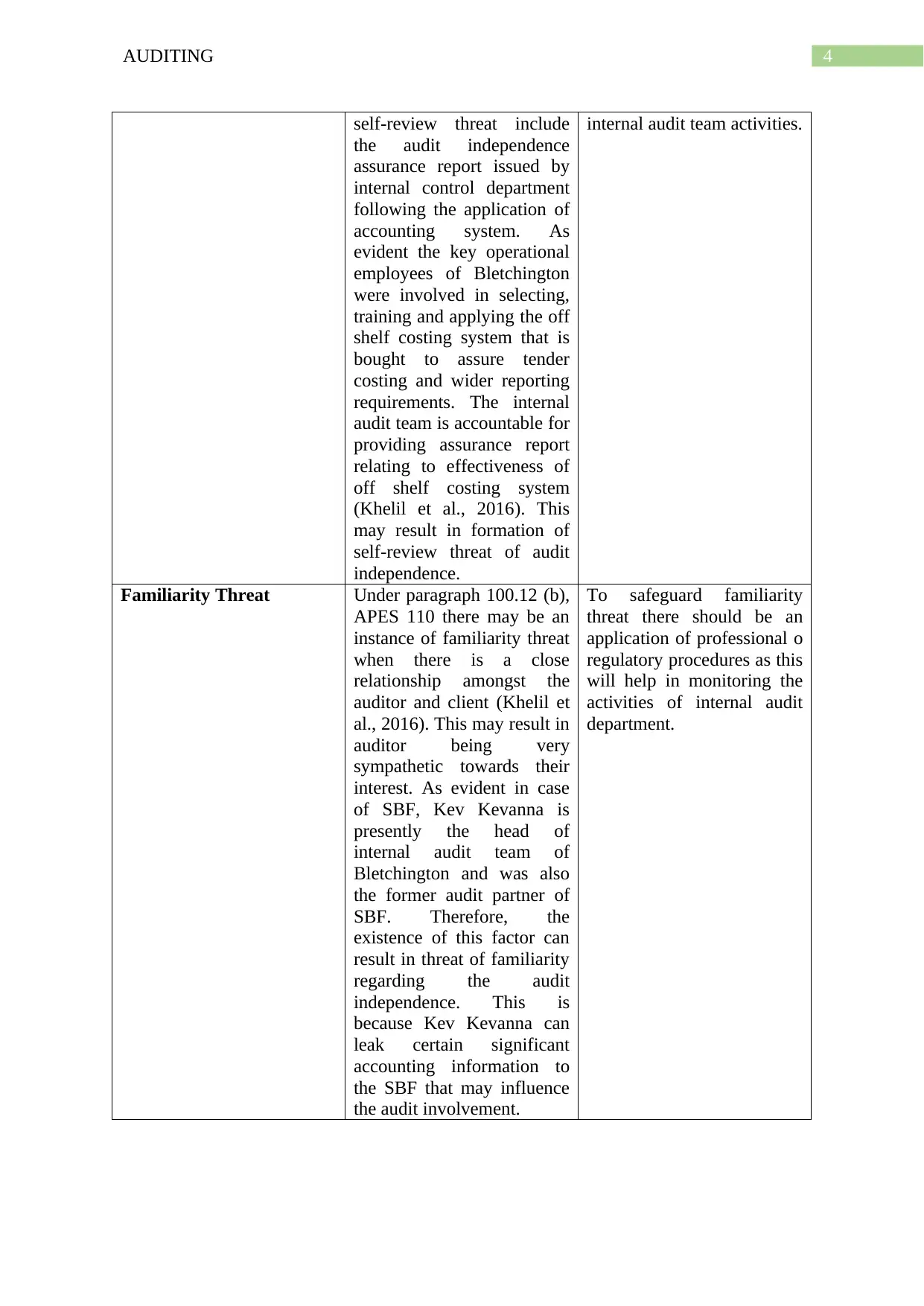
4AUDITING
self-review threat include
the audit independence
assurance report issued by
internal control department
following the application of
accounting system. As
evident the key operational
employees of Bletchington
were involved in selecting,
training and applying the off
shelf costing system that is
bought to assure tender
costing and wider reporting
requirements. The internal
audit team is accountable for
providing assurance report
relating to effectiveness of
off shelf costing system
(Khelil et al., 2016). This
may result in formation of
self-review threat of audit
independence.
internal audit team activities.
Familiarity Threat Under paragraph 100.12 (b),
APES 110 there may be an
instance of familiarity threat
when there is a close
relationship amongst the
auditor and client (Khelil et
al., 2016). This may result in
auditor being very
sympathetic towards their
interest. As evident in case
of SBF, Kev Kevanna is
presently the head of
internal audit team of
Bletchington and was also
the former audit partner of
SBF. Therefore, the
existence of this factor can
result in threat of familiarity
regarding the audit
independence. This is
because Kev Kevanna can
leak certain significant
accounting information to
the SBF that may influence
the audit involvement.
To safeguard familiarity
threat there should be an
application of professional o
regulatory procedures as this
will help in monitoring the
activities of internal audit
department.
self-review threat include
the audit independence
assurance report issued by
internal control department
following the application of
accounting system. As
evident the key operational
employees of Bletchington
were involved in selecting,
training and applying the off
shelf costing system that is
bought to assure tender
costing and wider reporting
requirements. The internal
audit team is accountable for
providing assurance report
relating to effectiveness of
off shelf costing system
(Khelil et al., 2016). This
may result in formation of
self-review threat of audit
independence.
internal audit team activities.
Familiarity Threat Under paragraph 100.12 (b),
APES 110 there may be an
instance of familiarity threat
when there is a close
relationship amongst the
auditor and client (Khelil et
al., 2016). This may result in
auditor being very
sympathetic towards their
interest. As evident in case
of SBF, Kev Kevanna is
presently the head of
internal audit team of
Bletchington and was also
the former audit partner of
SBF. Therefore, the
existence of this factor can
result in threat of familiarity
regarding the audit
independence. This is
because Kev Kevanna can
leak certain significant
accounting information to
the SBF that may influence
the audit involvement.
To safeguard familiarity
threat there should be an
application of professional o
regulatory procedures as this
will help in monitoring the
activities of internal audit
department.
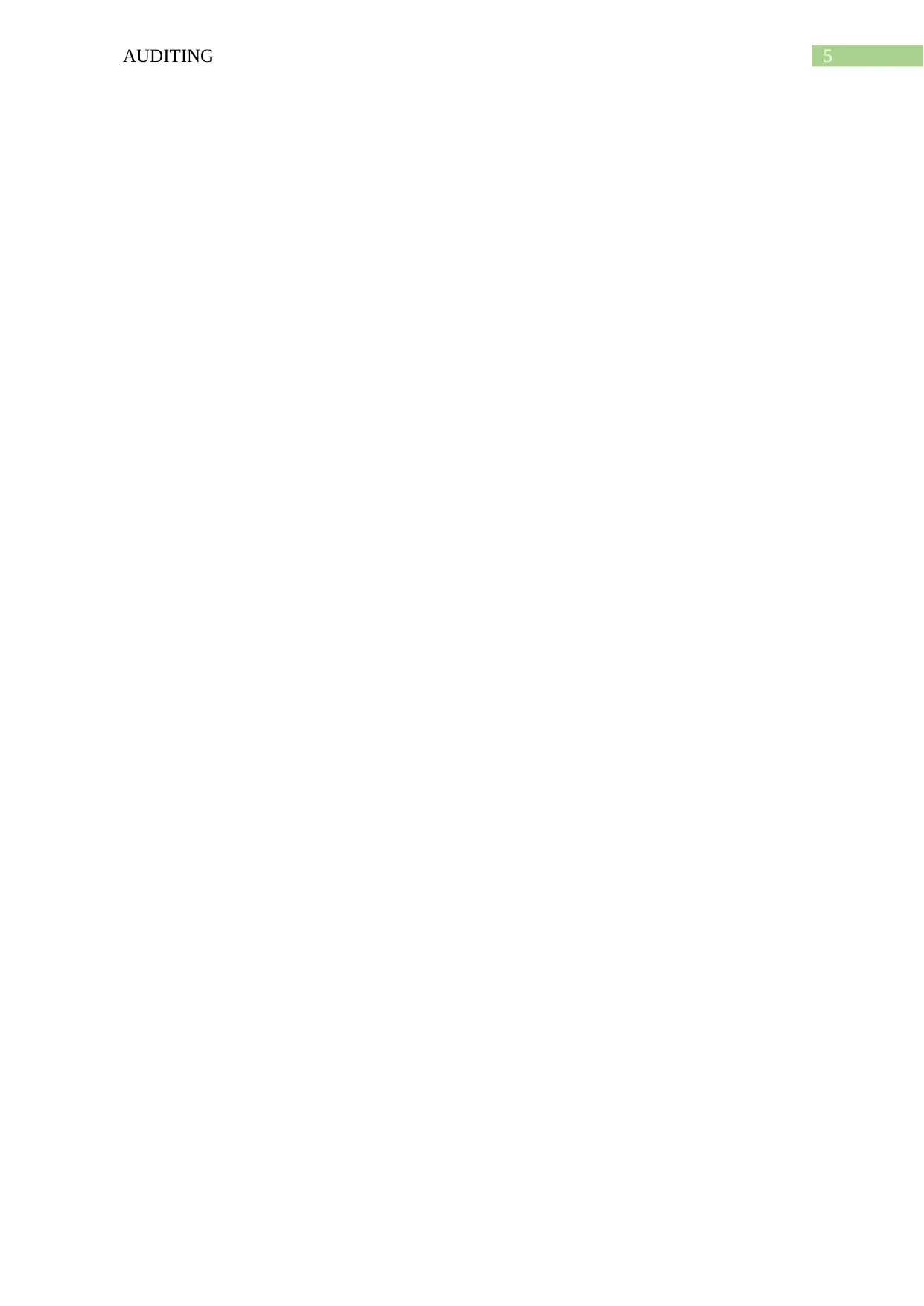
5AUDITING
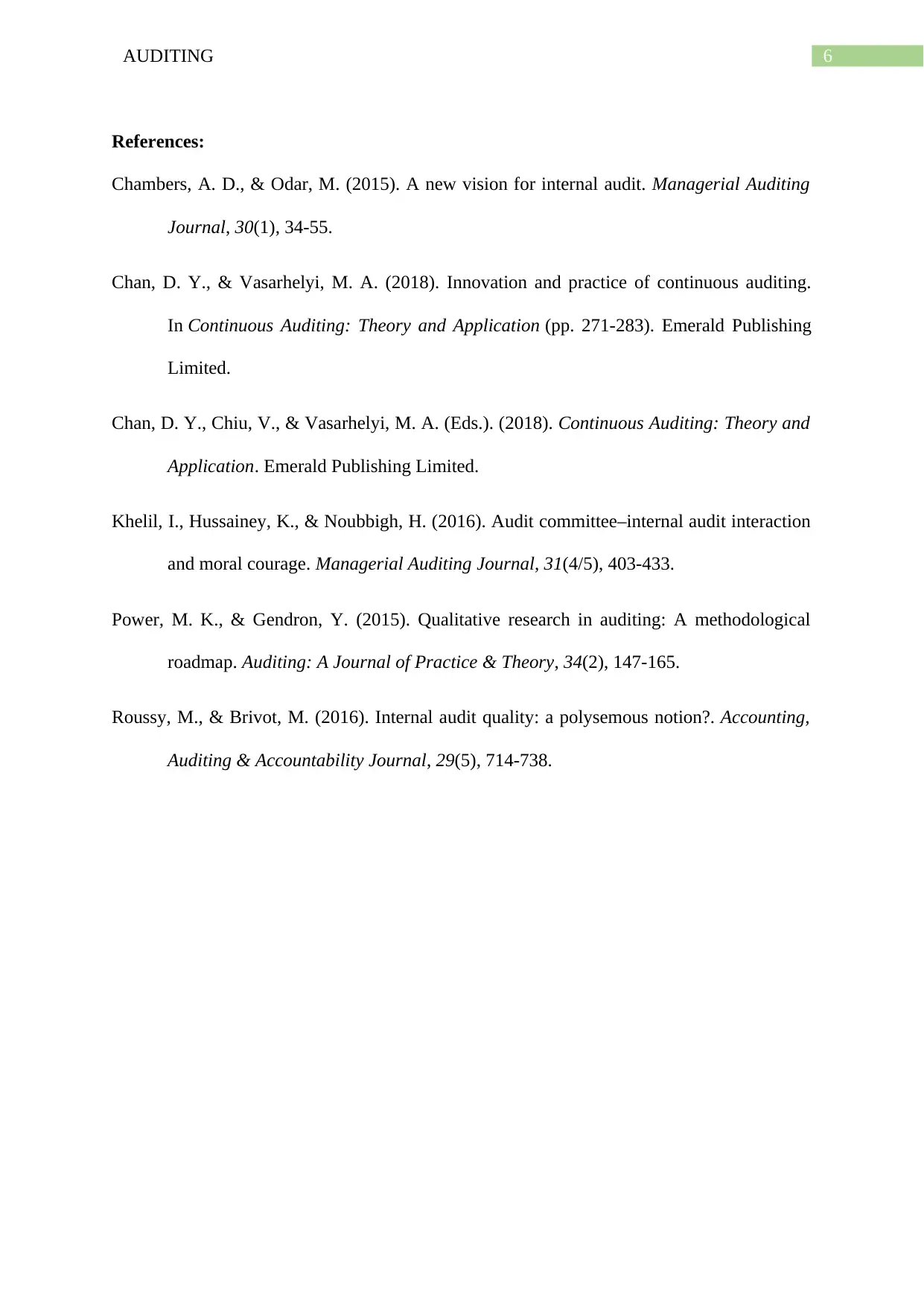
6AUDITING
References:
Chambers, A. D., & Odar, M. (2015). A new vision for internal audit. Managerial Auditing
Journal, 30(1), 34-55.
Chan, D. Y., & Vasarhelyi, M. A. (2018). Innovation and practice of continuous auditing.
In Continuous Auditing: Theory and Application (pp. 271-283). Emerald Publishing
Limited.
Chan, D. Y., Chiu, V., & Vasarhelyi, M. A. (Eds.). (2018). Continuous Auditing: Theory and
Application. Emerald Publishing Limited.
Khelil, I., Hussainey, K., & Noubbigh, H. (2016). Audit committee–internal audit interaction
and moral courage. Managerial Auditing Journal, 31(4/5), 403-433.
Power, M. K., & Gendron, Y. (2015). Qualitative research in auditing: A methodological
roadmap. Auditing: A Journal of Practice & Theory, 34(2), 147-165.
Roussy, M., & Brivot, M. (2016). Internal audit quality: a polysemous notion?. Accounting,
Auditing & Accountability Journal, 29(5), 714-738.
References:
Chambers, A. D., & Odar, M. (2015). A new vision for internal audit. Managerial Auditing
Journal, 30(1), 34-55.
Chan, D. Y., & Vasarhelyi, M. A. (2018). Innovation and practice of continuous auditing.
In Continuous Auditing: Theory and Application (pp. 271-283). Emerald Publishing
Limited.
Chan, D. Y., Chiu, V., & Vasarhelyi, M. A. (Eds.). (2018). Continuous Auditing: Theory and
Application. Emerald Publishing Limited.
Khelil, I., Hussainey, K., & Noubbigh, H. (2016). Audit committee–internal audit interaction
and moral courage. Managerial Auditing Journal, 31(4/5), 403-433.
Power, M. K., & Gendron, Y. (2015). Qualitative research in auditing: A methodological
roadmap. Auditing: A Journal of Practice & Theory, 34(2), 147-165.
Roussy, M., & Brivot, M. (2016). Internal audit quality: a polysemous notion?. Accounting,
Auditing & Accountability Journal, 29(5), 714-738.
1 out of 7
Related Documents
Your All-in-One AI-Powered Toolkit for Academic Success.
+13062052269
info@desklib.com
Available 24*7 on WhatsApp / Email
![[object Object]](/_next/static/media/star-bottom.7253800d.svg)
Unlock your academic potential
© 2024 | Zucol Services PVT LTD | All rights reserved.





